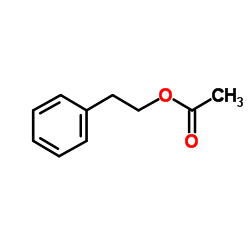Phenethyl acetate

Phenethyl acetate structure
|
Common Name | Phenethyl acetate | ||
|---|---|---|---|---|
| CAS Number | 103-45-7 | Molecular Weight | 164.201 | |
| Density | 1.0±0.1 g/cm3 | Boiling Point | 233.3±9.0 °C at 760 mmHg | |
| Molecular Formula | C10H12O2 | Melting Point | -31 °C | |
| MSDS | Chinese USA | Flash Point | 101.7±0.0 °C | |
|
Combined effects of nutrients and temperature on the production of fermentative aromas by Saccharomyces cerevisiae during wine fermentation.
Appl. Microbiol. Biotechnol. 99(5) , 2291-304, (2015) Volatile compounds produced by yeast during fermentation greatly influence the organoleptic qualities of wine. We developed a model to predict the combined effects of initial nitrogen and phytosterol content and fermentation temperature on the production of v... |
|
|
Comparative metabolic profiling to investigate the contribution of O. oeni MLF starter cultures to red wine composition.
J. Ind. Microbiol. Biotechnol. 39(3) , 477-94, (2012) In this research work we investigated changes in volatile aroma composition associated with four commercial Oenococcus oeni malolactic fermentation (MLF) starter cultures in South African Shiraz and Pinotage red wines. A control wine in which MLF was suppress... |
|
|
Impact of addition of aromatic amino acids on non-volatile and volatile compounds in lychee wine fermented with Saccharomyces cerevisiae MERIT.ferm.
Int. J. Food Microbiol. 170 , 12-20, (2014) The impact of individual aromatic amino acid addition (L-phenylalanine, L-tryptophan and L-tyrosine) on non-volatile and volatile constituents in lychee wine fermented with Saccharomyces cerevisiae var. cerevisiae MERIT.ferm was studied. None of the added ami... |
|
|
Adaptive evolution of the lager brewing yeast Saccharomyces pastorianus for improved growth under hyperosmotic conditions and its influence on fermentation performance.
FEMS Yeast Res. 13(3) , 335-49, (2013) An adaptive evolution method to obtain stable Saccharomyces pastorianus brewing yeast variants with improved fermentation capacity is described. The procedure involved selection for rapid growth resumption at high osmotic strength. It was applied to a lager s... |
|
|
Fragrance material review on phenethyl acetate.
Food Chem. Toxicol. 50 Suppl 2 , S491-7, (2012) A toxicologic and dermatologic review of phenethyl acetate when used as a fragrance ingredient is presented. Phenethyl acetate is a member of the fragrance structural group aryl alkyl alcohol simple acid esters (AAASAE). The AAASAE fragrance ingredients are p... |
|
|
Generation of phenylpropanoid pathway-derived volatiles in transgenic plants: rose alcohol acetyltransferase produces phenylethyl acetate and benzyl acetate in petunia flowers.
Plant Mol. Biol. 60(4) , 555-63, (2006) Esters are important contributors to the aroma of numerous flowers and fruits. Acetate esters such as geranyl acetate, phenylethyl acetate and benzyl acetate are generated as a result of the action of alcohol acetyltransferases (AATs). Numerous homologous AAT... |
|
|
Enzymatic synthesis of rose aromatic ester (2-phenylethyl acetate) by lipase.
J. Sci. Food Agric. 92(10) , 2141-7, (2012) 2-Phenylethyl acetate (2-PEAc) is a highly valued natural volatile ester with a rose-like odour that is widely used to add scent or flavour to cosmetics, soaps, foods and drinks. In this study, 2-PEAc was synthesised enzymatically by transesterification of vi... |
|
|
[Experimental study of the toxic properties of phenylethyl alcohol and phenylethyl acetate].
Gig. Sanit. (10) , 83-4, (1987)
|
|
|
Ghanaian cocoa bean fermentation characterized by spectroscopic and chromatographic methods and chemometrics.
J. Food Sci. 75(6) , S300-7, (2010) Export of cocoa beans is of great economic importance in Ghana and several other tropical countries. Raw cocoa has an astringent, unpleasant taste, and flavor, and has to be fermented, dried, and roasted to obtain the characteristic cocoa flavor and taste. In... |
|
|
Increasing the levels of 2-phenylethyl acetate in wine through the use of a mixed culture of Hanseniaspora osmophila and Saccharomyces cerevisiae.
Int. J. Food Microbiol. 135(1) , 68-74, (2009) The impact of mixed cultures of Hanseniaspora osmophila and Saccharomyces cerevisiae with different initial yeast ratios on wine composition has been examined. The mixed culture significantly affected sugar consumption, the main enological parameters and este... |